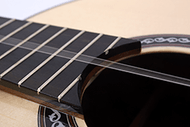Addressing D String Buzz
Mar 25th 2024
 You reach for your guitar. Your fingers are itching to work on some passages for an
You reach for your guitar. Your fingers are itching to work on some passages for an
upcoming recital. You re-tune the new set of strings you put on last night and start running through the piece, and…One of your strings is buzzing. Usually, finding the source for these buzzes is pretty straightforward, but today, you’re stumped.
The little gremlin seems to be hiding somewhere along the D string. You know it's not your setup. You recently had your luthier raise the saddle, and adjust the relief. The frets are fine. No buzz from the nut to the note. Your guitar sounded great before you installed a new set of heavy tension strings. You’ve run down the list of all of the obvious causes. Nothing you try is making a difference, so what do you do?
I’ve had the opportunity to perform a lot of setups and sort out a fair number of string buzz issues, but just the other day I was stumped with a similar conundrum for a client. I thought for sure someone else had run into a similar issue specific to the D string and had a possible solution, so I Googled it.
Luthier Steven D’Antonio on ClassicalGuitarDelCamp.com had a post that caught my eye. As chance would have it, he has a physics background which really enhanced his understanding of the mechanics of the nylon string. He states that there are two components to a vibrating string. First, is what he characterized as “traverse component” (the horizontal vibration that occurs every time you strum or pluck a string). But there’s another “longitudinal” vibration that runs down the length of the string. That vibration, D’Antonio asserts, is generated due to differences in the mass of the string created when the string is not plucked precisely at its midpoint. Similarly, the 4th string in nylon set is wound just a bit looser than both the 6th or 5th string, and this creates a difference in what he termed the “relative masses” of nylon to metal.
So what does that all mean?
The metal that winds around the nylon filament core is a bit loose. When the string plucked is set up a bit looser, these longitudinal waves produce a buzz-like sound that is not due to the string rattling against a fret.
So, if the relative masses of the nylon to metal are different, how do you reduce the difference?
Tighten the windings.
HOW TO TIGHTEN WINDINGS: With the string attached at the bridge, gently pull the string taut from the loose end and roll the string in between your thumb and forefinger in the same direction as the windings a few times.

By this point, I was ready to try anything to eliminate the buzz on what was otherwise a perfectly set up guitar. I proceeded to remove the string from the tuning machine roller and gave it a few twists, reattached it to the roller, and tuned it back up to pitch. With much trepidation I played a few notes… and voila! The buzz was gone!
Who would have thought that a couple of twists would make the difference? Granted, the physics here cannot be applied to every string buzz problem, but it’s certainly another bit of knowledge to put in your tool kit.
It is anomalies like this that underscore the many idiosyncrasies one has to face when setting up a nylon string guitar for optimal playability and sound production. Each guitar has a character and personality all its own and presents its own challenges to bring out the best it has to offer. Of course, that's what makes playing them all the more satisfying. Enjoy!

